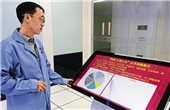Yang Guangwen: Builder of the Most Powerful Computer
China Today by Lu Rucai, October 13, 2016 Adjust font size:
Vital to Upgrade Manufacturing
The National Supercomputing Center was established in Wuxi, a city in Jiangsu Province, east China. Jiangsu is one of the country’s biggest manufacturing bases. The center was set up here, Yang Guangwen said, in order to transform manufacturing in the province.
An area forming only 1 percent of China’s territory, Jiangsu contributes around one tenth of the country’s GDP. Upgrading and transforming Jiangsu’s manufacturing is of great value to other provinces.
To build the center, Jiangsu’s provincial government and Wuxi’s municipal government each respectively invested RMB 600 million, and gave Tsinghua University responsibility for its operation.
“Made in China 2025,” an initiative recently launched by the Chinese government, focuses on high design level. Yang Guangwen commented: “Only if the design level improves can the manufacturing standard be raised.” The design and simulation process in the post-manufacturing stage cannot be conducted without the use of supercomputers. “We are trying to build a base for industrial and technological innovation,” Yang said.
It is no easy task. Many companies currently use copycat or manual design, and the simulation and design software market is dominated by imported commercial products.
“What we are going to do is simulation and design in bulk,” Yang explained. In the car manufacturing sector, for example, destructive collision tests are used for safety testing. “Now we can use the supercomputer to do a numerical simulation,” Yang said, “which will cut down on experimental loss and shorten the cycle.”
The same concept can also be used in aircraft manufacturing and performance tracking. “The supercomputers are able to analyze data collected by the sensor, thus making it possible to timely spot problems and potential threats in performance, so reducing the probability of accidents.” Yang hopes to tap the supercomputer’s potential and build a complete industrial chain from design and manufacturing to data analysis. “Combining supercomputing and big data can efficiently manage the entire product lifecycle.”
But a more urgent problem for Yang is finding long-term industrial clients, for example, key national projects or important manufacturers. He believes Sunway TaihuLight can help clients to develop their own core parallel software, which will assuredly upgrade lower-reach manufacturing.
China is currently the world leader in terms of supercomputer quantity, with 167 Chinese supercomputers listed in the TOP500 rankings. The U.S. is a close second. In terms of application, however, China still lags behind. “It will take a long time to close the gap, and we need to promote applications among companies with demand,” Yang said. In China the R&D team is mainly composed of computing scientists, while in foreign countries up to two thirds are application developers.
One of six supercomputing centers in China, the National Supercomputing Center in Wuxi hopes to provide programs, models and other resources in order to establish labs jointly with application institutions, thus to expand the scale of application.
“China has invested hugely in scientific and technological research, even surpassing the U.S. in some fields,” said Fu Haohuan, “so many researchers then working overseas returned to complete their projects in China, as here they can find the resources they could only long for in other countries.” Fu said China believes science and technology will play a huge role in future, and the idea itself serves to promote the sector’s development.
“We can build world-class high-speed railways, but the fluid design and most of the software for simulation is commercial software imported from other countries,” Fu Haohuan said. “Developing our own software is a problem we need to tackle. Now we can try by using world’s fastest computer. Isn’t that a great opportunity?”

